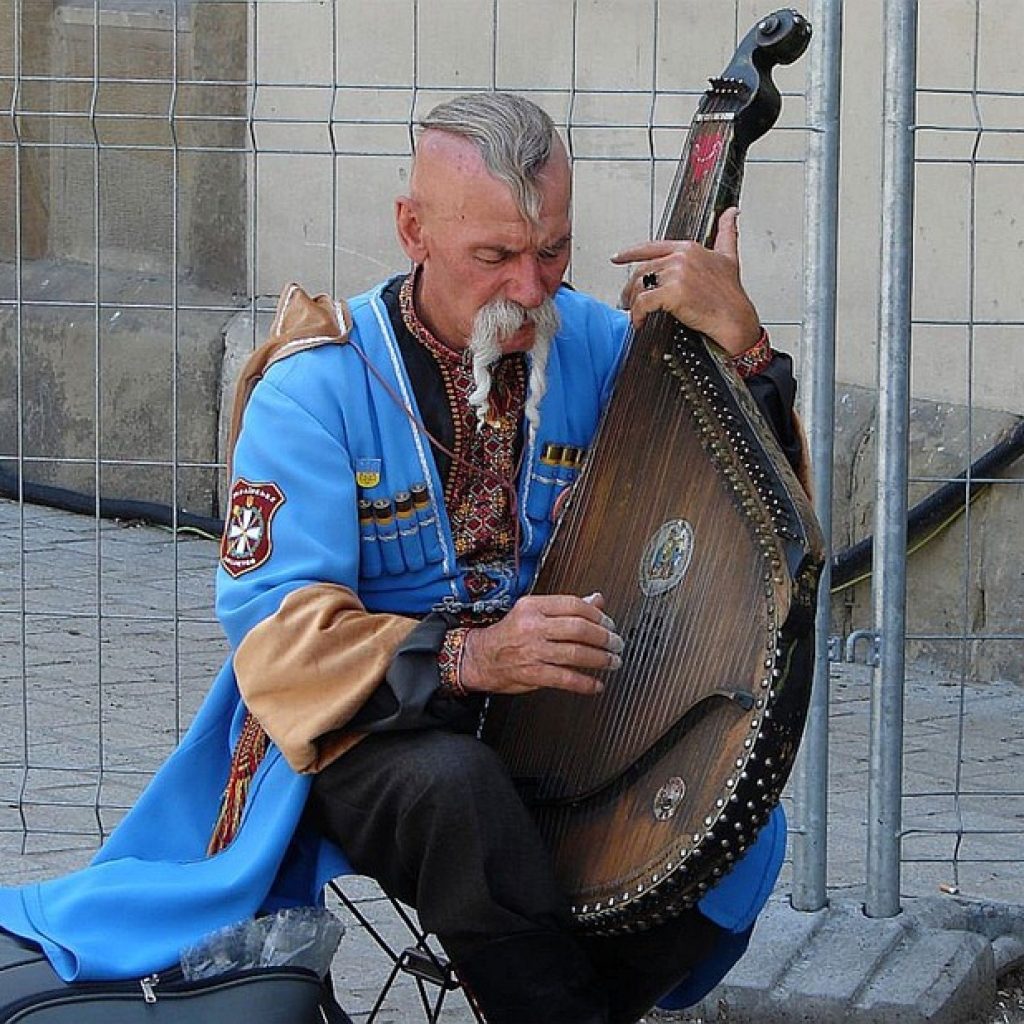The Bandura
The bandura is a traditional Ukrainian plucked-string folk instrument, which blends characteristics of the zither and lute. Historically, it was sometimes referred to as a kobza. Early versions from around 1700 had 5 to 12 strings and resembled lutes. In the 20th century, the number of strings evolved, increasing to 31 strings in 1926, and eventually reaching 56 to 68 strings on modern “concert” instruments by (1954).


Individuals who play the bandura are called bandurists. During the 19th and early 20th centuries, the traditional bandura players, many of whom were blind, were commonly known as kobzars. The word “bandura” is thought to have made its way into the Ukrainian language from Polish, with potential origins in Latin or the Greek terms “pandora” or “pandura.” Some scholars propose that it could have been directly borrowed from Greek.
In traditional banduras, the back is typically carved from a single block of wood, which may be willow, poplar, cherry, or maple. However, since the 1960s, glued-back instruments have become more prevalent, and more recently, banduras with fiberglass backs have emerged. The soundboard, traditionally made from a type of spruce, is used to produce the instrument’s sound. For the wrest planks and bridge, hardwoods like birch are commonly employed.
Originally, the bandura was a diatonic instrument, and even with the addition of chromatic strings in the 1920s, it has remained predominantly played in its diatonic form. Nowadays, most modern concert instruments are equipped with mechanisms that enable quick re-tuning into various keys, a feature first introduced in the late 1950s. Khotkevych, Leonid Haydamaka, Peter Honcharenko, Skliar, Herasymenko, and William Vetzal have significantly contributed to the advancement of contemporary bandura construction.


Since the 1980s, there has been a revival of interest in playing the authentic folk version of the bandura, initiated by students of Heorhy Tkachenko, such as Mykola Budnyk, Volodymyr Kushpet, Mykola Tovkailo, and Victor Mishalow. This movement has been continued by their students, who have formed kobzar guilds led by Mikhailo Khai, Kost Cheremsky, and Jurij Fedynskyj. Formal courses and handbooks have been developed for the instrument. Present-day makers of the bandura, including the late Budnyk, Tovkailo, Rusalim Kozlenko, Vasyl Boyanivsky, Fedynskyj, and Bill Vetzal, are notable figures in the field. In recognition of authentic bandura playing, a category has been included in the Hnat Khotkevych International Folk Instruments competition, held in Kharkiv every three years..
How do I play the instrument?
The bass side of the bandura should be on your left, and the treble side should be on your right. Pluck the strings with your right-hand fingers (thumb, index, and middle fingers) on the treble side and your left-hand fingers (thumb, index, and middle fingers) on the bass side. These pleksi are placed on the thumb and index fingers of both hands to pluck the strings. In addition to plucking, you can use your right hand to strum the treble strings for a different sound. Use your left hand to press down on the strings to change the pitch and produce different notes. The frets on the bandura’s neck help determine the pitch of the notes.
How long does it take to learn?
It takes Several months to learn how to play the bandura
Is there special equipment needed for the instrument?
Yes, there are needs for special equipment such as the Srap which is used by some bandurists to help support the weight of the instrument and to allow for playing while standing, and a tuner which is a tool used to accurately tune the strings of the bandura to the correct pitches.
Are there any instruments similar to this one?
Yes. Instruments such as the Kobza, Gusli, and Dombra are similar to this.

Rock with a Star!
Let’s enjoy the sound of this instrument through this wonderful performance by Julian Kytasty
Julian Kytasty, also known as Юліян Китастий, is a talented American musician and conductor of Ukrainian heritage. He is a composer, singer, kobzar (a traditional Ukrainian bard), bandurist (a player of the bandura), flautist, and conductor. Born on January 23, 1958, in Detroit, Michigan, he comes from a family of refugees.

